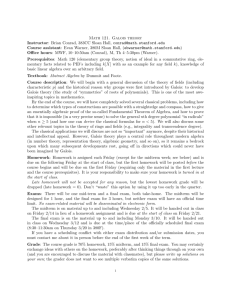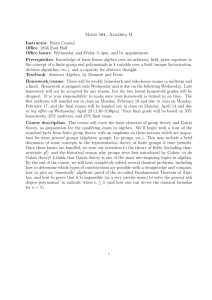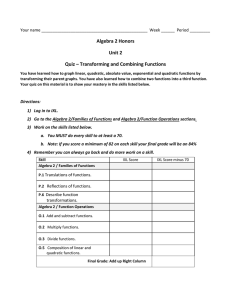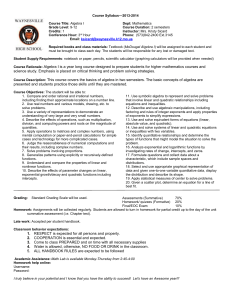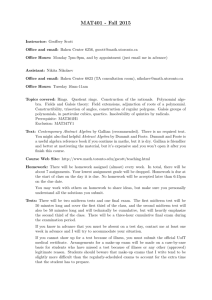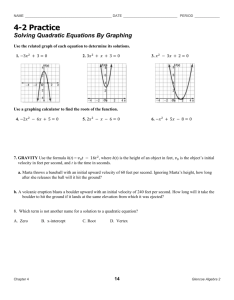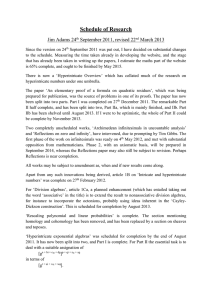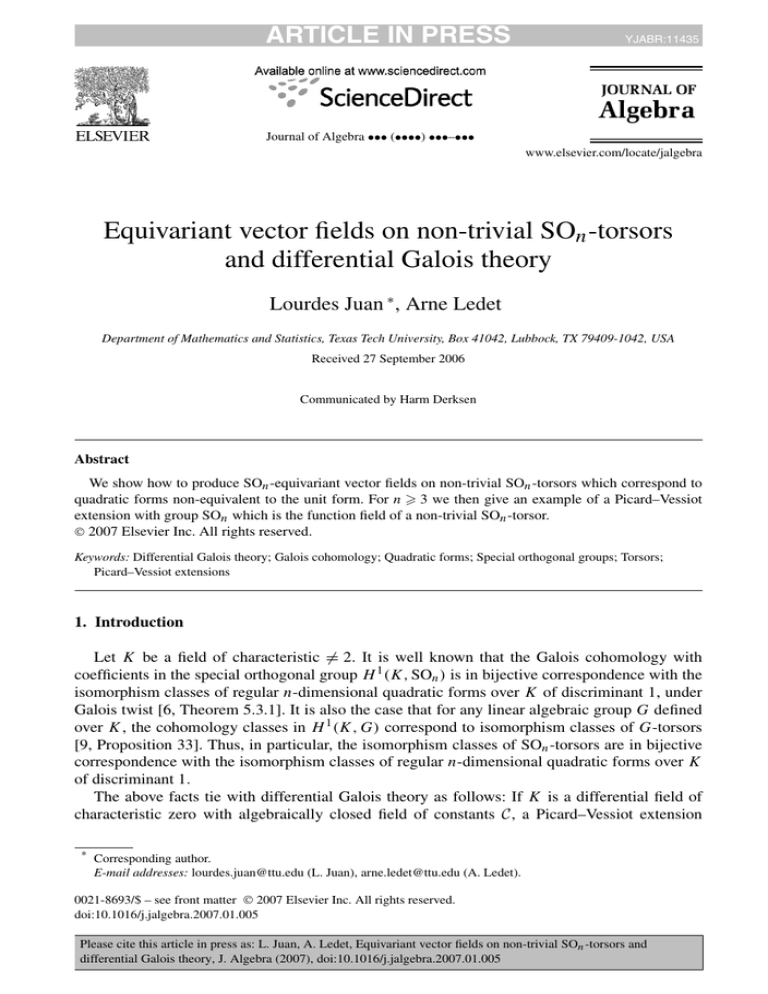
ARTICLE IN PRESS
JID:YJABR
AID:11435 /FLA
YJABR:11435
[m1+; v 1.69; Prn:1/02/2007; 14:31] P.1 (1-11)
Journal of Algebra ••• (••••) •••–•••
www.elsevier.com/locate/jalgebra
Equivariant vector fields on non-trivial SOn-torsors
and differential Galois theory
Lourdes Juan ∗ , Arne Ledet
Department of Mathematics and Statistics, Texas Tech University, Box 41042, Lubbock, TX 79409-1042, USA
Received 27 September 2006
Communicated by Harm Derksen
Abstract
We show how to produce SOn -equivariant vector fields on non-trivial SOn -torsors which correspond to
quadratic forms non-equivalent to the unit form. For n 3 we then give an example of a Picard–Vessiot
extension with group SOn which is the function field of a non-trivial SOn -torsor.
© 2007 Elsevier Inc. All rights reserved.
Keywords: Differential Galois theory; Galois cohomology; Quadratic forms; Special orthogonal groups; Torsors;
Picard–Vessiot extensions
1. Introduction
Let K be a field of characteristic = 2. It is well known that the Galois cohomology with
coefficients in the special orthogonal group H 1 (K, SOn ) is in bijective correspondence with the
isomorphism classes of regular n-dimensional quadratic forms over K of discriminant 1, under
Galois twist [6, Theorem 5.3.1]. It is also the case that for any linear algebraic group G defined
over K, the cohomology classes in H 1 (K, G) correspond to isomorphism classes of G-torsors
[9, Proposition 33]. Thus, in particular, the isomorphism classes of SOn -torsors are in bijective
correspondence with the isomorphism classes of regular n-dimensional quadratic forms over K
of discriminant 1.
The above facts tie with differential Galois theory as follows: If K is a differential field of
characteristic zero with algebraically closed field of constants C, a Picard–Vessiot extension
* Corresponding author.
E-mail addresses: lourdes.juan@ttu.edu (L. Juan), arne.ledet@ttu.edu (A. Ledet).
0021-8693/$ – see front matter © 2007 Elsevier Inc. All rights reserved.
doi:10.1016/j.jalgebra.2007.01.005
Please cite this article in press as: L. Juan, A. Ledet, Equivariant vector fields on non-trivial SOn -torsors and
differential Galois theory, J. Algebra (2007), doi:10.1016/j.jalgebra.2007.01.005
ARTICLE IN PRESS
JID:YJABR
2
YJABR:11435
AID:11435 /FLA
[m1+; v 1.69; Prn:1/02/2007; 14:31] P.2 (1-11)
L. Juan, A. Ledet / Journal of Algebra ••• (••••) •••–•••
of K with group G = G(C) is the function field K(W ) of some K-irreducible G-torsor W (see
[7, Theorem 5.12] or [8, Theorem 1.28]).
If G is finite, W must be non-trivial since the trivial G-torsor is reducible unless G is the
trivial group. Thus, in the finite case, Picard–Vessiot G-extensions of K correspond to function
fields of non-trivial K-irreducible G-torsors. Moreover, the extension of the derivation of K to
a G-equivariant derivation of a Galois G-extension is automatic and hence so is the existence of
equivariant vector fields on the corresponding torsor.
So, from the point of view of differential Galois theory, the more interesting and challenging
cases occur when the connected component of the group is non-trivial and, in particular, when
the group G is connected.
If K ⊂ E are differential fields and S is a subset of E, we will write KS to denote the differential subfield of E generated by K and S. As usual, if G acts on the ring R as automorphisms,
R G will denote the fixed ring.
A Picard–Vessiot extension E ⊃ K with group G is also determined by the following data
[7, Proposition 3.9]:
(1) A G-equivariant derivation D on the G-module E, that extends the derivation of K = E G
with no new constants (note that D corresponds to a G-equivariant vector field on a Kirreducible G torsor W as above).
(2) A G-stable finite-dimensional C-vector space V , such that E = KV (a C-basis of V corresponds to an E-point of W ).
All G-torsors become trivial over K̄. Having a distinguished point, namely the identity element, the trivial G-torsor has a natural G-equivariant tangent space associated to it: the Lie
algebra of G. This tangent space is isomorphic to the K-vector space of G-equivariant derivations over K on the coordinate ring K[G].
When G is connected, any such derivation extends G-equivariantly to the function field K(G).
We then see that K(G) = KV , where V is the G-stable C-vector space spanned by the coordinate functions on G.
It appears that this natural G-equivariant differential structure on K(G) makes it a favorite
candidate when it comes to producing Picard–Vessiot extensions of K with connected group G.
In this paper we look at the case of function fields of non-trivial G-torsors, for connected
groups G. In particular, we show how one can produce SOn -equivariant vector fields on nontrivial SOn -torsors and use this to give an explicit example of a Picard–Vessiot extension which
is the function field of a non-trivial G-torsor, with G connected.
The reader is assumed to be familiar with the basic notions of the Picard–Vessiot theory. Some
good sources are [7,8].
2. Quadratic forms and torsors
For the convenience of the reader we recall the following basic facts about quadratic forms
and torsors.
2.1. Quadratic forms
Let K be a field of characteristic = 2. A quadratic form over K is a map q : V → K, where
V is a finite-dimensional K-vector space, such that q(x) = B(x, x) for some symmetric bilinear
Please cite this article in press as: L. Juan, A. Ledet, Equivariant vector fields on non-trivial SOn -torsors and
differential Galois theory, J. Algebra (2007), doi:10.1016/j.jalgebra.2007.01.005
ARTICLE IN PRESS
JID:YJABR
YJABR:11435
AID:11435 /FLA
[m1+; v 1.69; Prn:1/02/2007; 14:31] P.3 (1-11)
L. Juan, A. Ledet / Journal of Algebra ••• (••••) •••–•••
3
form B : V × V → K. Thus, if we pick a basis e1 , . . . , en for V , we get
⎛
⎞
x1
.
q(x) = (x1 , . . . , xn )A ⎝ .. ⎠ ,
xn
where x = x1 e1 + · · · + xn en , and A = (B(ei , ej ))i,j . We say that the quadratic form is represented by A in the given basis.
If we choose another basis for V , the matrix B representing q in the new basis will have the
form B = P T AP , where P ∈ GLn (K) is the coordinate transformation matrix for the two bases.
In particular: If q is represented by an invertible matrix in one basis, any matrix representing
it will be invertible. We then refer to the quadratic form as regular. In this case, the determinant
of a matrix representing q is called the discriminant of q. Since det(B) = det(P )2 det(A), the
discriminant is only determined up to a quadratic factor.
Two quadratic forms q : V → K and q : V → K are equivalent, if there exists a vector
space isomorphism f : V → V such that q(x) = q (f (x)) for all x ∈ V . In terms of matrices,
this means: if A represents q, and B represents q , there exists an invertible matrix P with
P T AP = B.
An equivalence of q with itself is called an isometry. The isometries of q form a group, called
the orthogonal group for q, denoted O(q). If we pick a basis for V , in which q is represented
by A, the orthogonal group consists of all matrices P with P T AP = A. In particular, an isometry
must have determinant ±1. The isometries with determinant 1 form a subgroup of O(q), called
the special orthogonal group and denoted SO(q).
In the special case of the quadratic form 1n : K n → K, given by 1n (x) = x12 + · · · + xn2 , the
orthogonal and special orthogonal groups are denoted by On (K) and SOn (K), respectively.
Every regular quadratic form is diagonalizable, i.e., representable by a diagonal matrix.
An excellent reference for quadratic forms is [5]. For a more comprehensive review of the
basic facts than the one provided here, see also Chapter 7 in [6].
We now show the following criterion which will be needed in our construction of a non-trivial
SOn -torsor:
Lemma 1. Let k be a field containing a primitive fourth root of unity, and let a1 , . . . , an−1 , n 3,
be indeterminates over k. Then the quadratic form a1 x12 +· · ·+an xn2 , where an = (a1 · · · an−1 )−1 ,
is not equivalent to 1n over k(a1 , . . . , an−1 ).
Proof. If it were, we would have
a1 x12 + · · · + an xn2 ∼ x12 + · · · + xn2 ,
and since
x12 + · · · + xn2 ∼ a1 x12 + a1 x22 + x32 + · · · + xn2 ,
it follows that
a1 x22 + · · · + xn2 ∼ a2 x22 + · · · + an xn2 ,
Please cite this article in press as: L. Juan, A. Ledet, Equivariant vector fields on non-trivial SOn -torsors and
differential Galois theory, J. Algebra (2007), doi:10.1016/j.jalgebra.2007.01.005
ARTICLE IN PRESS
JID:YJABR
4
YJABR:11435
AID:11435 /FLA
[m1+; v 1.69; Prn:1/02/2007; 14:31] P.4 (1-11)
L. Juan, A. Ledet / Journal of Algebra ••• (••••) •••–•••
and hence that the quadratic form a2 x22 + · · · + an xn2 represents 1. Note that a2 , . . . , an are
algebraically independent over k. Now, by assumption we have polynomials f, f2 , . . . , fn ∈
k[a2 , . . . , an ] such that
a2 f22 + · · · + an fn2 = f 2 ,
and f = 0. Let f˜ be the lowest-degree term in f as a polynomial in a2 . Then f˜ 2 is the sum of
the lowest-degree terms in ai fi2 for those i > 2 for which fi has the same lowest degree in a2
as f . The term a2 f22 cannot contribute, since its lowest degree in a2 is odd. Therefore we have
that
a3 f˜32 + · · · + an f˜n2 = f˜ 2 ,
for polynomials f˜, f˜3 , . . . , f˜n ∈ k[a3 , . . . , an ]. By recursion, we end up with one indeterminate
and a statement
g 2 = an gn2
for g, gn ∈ k[x], g = 0, which is clearly impossible.
2
2.2. Torsors
Let K be a perfect field, and let it be understood in this section that all varieties are defined
over K, and that they are reduced of finite type, i.e., that they are spectra of finitely generated
commutative K-algebras with no nilpotents.
Given an algebraic group G, a variety V is then said to be a G-torsor, if G acts on V and the
induced map G × V → V × V corresponding to (σ, x) → (σ x, x) is an isomorphism of varieties
(see [8]).
The algebraic group G is itself a G-torsor in the obvious way, and is said to be trivial. The
trivial G-torsor is characterized by having K-rational points.
For a finite group G, the G-torsors are the spectra of Galois algebras over K with Galois
group G. Here, the trivial G-torsor corresponds to the split Galois algebra K |G| , whereas Galois
field extensions correspond to irreducible G-torsors.
Scalar extensions of torsors are again torsors, over the scalar-extended group variety.
Every G-endomorphism on a G-torsor is automatically an automorphism. In the case of the
trivial G-torsor G itself, the G-automorphisms form a group isomorphic to the group G(K) of
K-rational points.
Theorem 1. (See [9, Proposition 33].) The isomorphism classes of G-torsors correspond bijectively to the equivalence classes of crossed homomorphisms in H 1 (K, G).
Here, a crossed homomorphism is a continuous map e : Gal(K) → G(K̄), where Gal(K) is
the absolute Galois group of K, satisfying
eσ τ = e σ σ eτ ,
Please cite this article in press as: L. Juan, A. Ledet, Equivariant vector fields on non-trivial SOn -torsors and
differential Galois theory, J. Algebra (2007), doi:10.1016/j.jalgebra.2007.01.005
ARTICLE IN PRESS
JID:YJABR
YJABR:11435
AID:11435 /FLA
[m1+; v 1.69; Prn:1/02/2007; 14:31] P.5 (1-11)
L. Juan, A. Ledet / Journal of Algebra ••• (••••) •••–•••
5
and two crossed homomorphisms e and e
are equivalent if
eσ
= f eσ σf −1
for some f ∈ G(K̄).
A crossed homomorphism e gives rise to a torsor as follows: Let H be the Hopf algebra
corresponding to G. On the scalar extension H̄ = H ⊗K K̄, we then have an obvious Gal(K)action, and we define an e-twisted action by
σ
x = eσ (σ x),
σ ∈ Gal(K).
The fixed ring R = H̄ Gal(K) under this action is then the coordinate ring for a G-torsor, with the
G-action induced by the restriction α : R → H ⊗K R of the co-multiplication on H̄ .
For more on G-torsors see [9,10].
3. The twisted Lie algebra
Let G ⊆ GLn (C) be a connected linear algebraic group, and let H = K[X, 1/ det(X)] be
the coordinate ring over K, where X is a generic point of G. Given a crossed homomorphism
e : Gal(K) → G(K̄), we get an e-twisted Galois action on H̄ = K̄ ⊗K H by
σ
z = eσ (σ z),
and a corresponding coordinate ring for a torsor T = H̄ Gal(K) . Here, the G-action on H (and H̄ )
is given by
g
X = Xg,
g ∈ G.
Now, by Speiser’s Theorem (see [6, Exercise 1.61]), there exists P ∈ GLn (K̄) with eσ =
P σ P −1 , and with Y = XP we have
σ
Y = XP σ P −1 σ P = XP = Y,
from which it follows that we can realize T explicitly inside H̄ as T = K[Y, 1/ det(Y )].
We then have a G-action on T given by
g
Y = g −1 Y,
g ∈ G.
Define a derivation on T by
Y
= YB
for some B ∈ Mn (K). The fact that the derivation is expressed by multiplication from the right
guarantees that the G-action on T is differential.
It then extends to H̄ , where
X = XA = X P BP −1 − P P −1 ,
Please cite this article in press as: L. Juan, A. Ledet, Equivariant vector fields on non-trivial SOn -torsors and
differential Galois theory, J. Algebra (2007), doi:10.1016/j.jalgebra.2007.01.005
ARTICLE IN PRESS
JID:YJABR
6
YJABR:11435
AID:11435 /FLA
[m1+; v 1.69; Prn:1/02/2007; 14:31] P.6 (1-11)
L. Juan, A. Ledet / Journal of Algebra ••• (••••) •••–•••
and hence, if we let g denote the Lie algebra Lie(G), we see that
A ∈ g(K̄)
and
B = P −1 AP + P −1 P ∈ P −1 P + P −1 g(K̄)P ∩ Mn (K).
Here, P −1 g(K̄)P is a Lie algebra, and since eσ = P σ P −1 ∈ G(K̄), meaning that conjugation
by eσ is an automorphism on g(K̄), we see that this Lie algebra is closed under the (un-twisted)
Galois action. Thus, by the Invariant Basis Lemma (see [3], [6, Exercise 1.61], or [2, Lemma 5]),
Gal(K)
T = P −1 g(K̄)P
is a Lie algebra over K of the same dimension, which we can think of as being obtained by a
Galois twist of g(K).
Remark. The Galois twist can be realized by interpreting eσ as an automorphism of g(K̄) by
conjugation which gives rise to a Galois twist P TP −1 (∼
= T) of g(K). For that reason, we call T
the twisted Lie algebra associated to the torsor with coordinate ring T .
Proposition 1. The possible choices of B form a co-space with respect to T. I.e., there exist
possible B’s, and if C is one of them, all the others are the elements of C + T.
Proof. Clearly we can define a derivation on H̄ by X = 0, and get by computations as
above that Y = Y P −1 P . Applying the twisted Galois action, we get conjugate derivations
Y = Y σ P −1 σ P for all σ ∈ Gal(K), for which we have
X = X P σ P −1 σ P P −1 − P P −1 ,
and therefore
P σ P −1 σ P P −1 − P P −1 ∈ g(K̄),
or
σ P −1 P − P −1 P ∈ P −1 g(K̄)P .
Obviously, σ → σ (P −1 P ) − P −1 P is an additive crossed homomorphism, and since
P −1 g(K̄)P is a finite-dimensional K̄-vector space with a semilinear Gal(K)-action, the additive
Hilbert 90 gives us that it is principal, i.e., that there exists a D ∈ P −1 g(K̄)P with
σ P −1 P − P −1 P = σ D − D,
σ ∈ Gal(K).
In particular, P −1 P − D is Gal(K)-invariant, and so
Please cite this article in press as: L. Juan, A. Ledet, Equivariant vector fields on non-trivial SOn -torsors and
differential Galois theory, J. Algebra (2007), doi:10.1016/j.jalgebra.2007.01.005
ARTICLE IN PRESS
JID:YJABR
YJABR:11435
AID:11435 /FLA
[m1+; v 1.69; Prn:1/02/2007; 14:31] P.7 (1-11)
L. Juan, A. Ledet / Journal of Algebra ••• (••••) •••–•••
7
−1 Gal(K) −1 Gal(K)
P P + P −1 g(K̄)P
= P P − D + P −1 g(K̄)P
Gal(K) −1 = P −1 P − D + P −1 g(K̄)P
= P P − D + T.
Thus, the possible choices for B form a co-space for T, as claimed.
2
4. The special orthogonal groups
For n ∈ N, the special orthogonal group is the subgroup
SOn = X ∈ GLn X t X = I, det(X) = 1
of GLn .
The corresponding Lie algebra son consists of all antisymmetric n × n matrices, from which
we immediately get that SOn has dimension 12 n(n − 1).
Let K be a field of characteristic = 2 as before, and let K̄sep denote its separable closure. The
correspondence between the cohomology classes in H 1 (K, SOn ) and the isomorphism classes
of regular n-dimensional quadratic forms of discriminant 1 can be realized as follows:
Given a crossed homomorphism e : Gal(K) → On (K̄sep ), we define the e-twisted Galois acn by
tion on K̄sep
σ
x = eσ (σ x),
n
x ∈ K̄sep
, σ ∈ Gal(K),
and get the twisted quadratic space by restricting the quadratic form 1n to the K-vector space Ve
of fixed points under this action. This defines a quadratic form q : Ve → K, since eσ is an isometry, so that 1n (σ x) = 1n (σ x) = σ 1n (x), making the image of a fixed point a fixed point, i.e., an
element in K. If e maps into SOn (K̄sep ), this space will have discriminant 1.
Thus, the isomorphism classes of SOn -torsors correspond to those of quadratic forms with
square discriminant. In particular, a quadratic form not equivalent to the unit form 1n will correspond to a non-trivial torsor.
Assume that K is a differential field of characteristic zero with algebraically closed field of
constants C. Let
q = a1 x12 + · · · + an xn2
be a regular quadratic form with a1 , . . . , an ∈ K ∗ and (say) d(q) = a1 · · · an = 1. Put
⎞
⎛ √a
1
√
a2
⎟
⎜
⎟,
P =⎜
..
⎠
⎝
.
√
an
with the square roots chosen to have product 1 as well, and
⎛
⎜
Q=⎜
⎝
⎞
a1
⎟
⎟.
⎠
a2
..
.
an
Please cite this article in press as: L. Juan, A. Ledet, Equivariant vector fields on non-trivial SOn -torsors and
differential Galois theory, J. Algebra (2007), doi:10.1016/j.jalgebra.2007.01.005
ARTICLE IN PRESS
JID:YJABR
8
YJABR:11435
AID:11435 /FLA
[m1+; v 1.69; Prn:1/02/2007; 14:31] P.8 (1-11)
L. Juan, A. Ledet / Journal of Algebra ••• (••••) •••–•••
We then have P t P = Q, and get a crossed homomorphism f : Gal(K) → SOn (K̄) by fσ =
P σ P −1 for σ ∈ Gal(K). This establishes the correspondence between isomorphism classes
of regular n-dimensional quadratic spaces with square discriminant over K and cohomology
classes of crossed homomorphisms (and between the former and the isomorphism classes of
SOn -torsors).
Assuming the quadratic form to be as above, the coordinate ring for the corresponding torsor
is then T = K[Y, 1/ det(Y )], where Y = XP for a generic SOn -point X. The defining relations
for Y are
YtY = Q
det(Y ) = 1
and
(thus we can omit 1/ det(Y ) in the description of T ). The SOn (C)-action on T is given by
Σ : Y → Σ −1 Y,
Σ ∈ SOn (C).
To find the derivations on T , we first conjugate a typical element of son (K̄):
⎛
0
⎜ −a12
⎜
−a
P −1 ⎜
⎜ . 13
⎝ ..
a12
0
−a23
..
.
−a1n
−a2n
⎛
0
⎜ √a1
⎜ − √ a12
⎜
a
⎜ √2
a
=⎜
⎜ − √a1 a13
3
⎜
..
⎜
⎝
.
√
a
− √an1 a1n
a13
a23
0
..
.
−a3n
√
a
√ 2 a12
a1
⎞
a1n
a2n ⎟
⎟
a3n ⎟ P
.. ⎟
. ⎠
···
···
···
..
.
···
0
√
a
− √a2 a23
3
..
.
√
a
− √an2 a2n
0
√
a
√ 3 a13
a1
√
a
√ 3 a23
a2
···
···
···
..
.
0
..
.
√
a
− √an3 a3n
···
√
⎞
a
√ n a1n
a1
√
⎟
a
√ n a2n ⎟
⎟
a2
⎟
√
⎟
a
√ n a3n ⎟ .
a3
⎟
⎟
⎠
..
.
0
We then observe that this matrix has its coefficients in K if and only if aij =
some bij ∈ K.
The relevant derivations on T thus have the form
√ √
ai / aj · bij for
Y = Y B,
where
⎛
a1
2a1
⎜ a
⎜ − 1 b12
⎜ a2
⎜
B = ⎜ a1
⎜ − a3 b13
⎜
..
⎝
.
a1
− an b1n
b12
b13
···
a2
2a2
b23
···
− aa23 b23
..
.
..
.
− aan2 b2n
a3
2a3
− aan3 b3n
···
..
.
···
b1n
⎞
⎟
b2n ⎟
⎟
⎟
b3n ⎟
⎟
.. ⎟
. ⎠
an
2an
and bij ∈ K.
Please cite this article in press as: L. Juan, A. Ledet, Equivariant vector fields on non-trivial SOn -torsors and
differential Galois theory, J. Algebra (2007), doi:10.1016/j.jalgebra.2007.01.005
ARTICLE IN PRESS
JID:YJABR
YJABR:11435
AID:11435 /FLA
[m1+; v 1.69; Prn:1/02/2007; 14:31] P.9 (1-11)
L. Juan, A. Ledet / Journal of Algebra ••• (••••) •••–•••
9
Note that in this case the twisted Lie algebra T over K consists of the matrices
⎛
0
⎜ − a1 b12
⎜ a2
⎜ a1
⎜ − a b13
⎜ 3
..
⎜
⎝
.
a1
− an b1n
b12
0
b13
b23
···
···
− aa23 b23
..
.
0
..
.
···
..
.
− aan2 b2n
− aan3 b3n
···
⎞
b1n
b2n ⎟
⎟
⎟
b3n ⎟
⎟
.. ⎟
. ⎠
(1)
0
and that
B ∈ P P −1 + T,
since P P −1 has coefficients in K.
5. Picard–Vessiot extension
Since the special orthogonal group SO2 is isomorphic to the multiplicative group, the case
n = 2 is completely trivial and we shall assume that n 3 in what follows.
From (1) we can go back to an element A = (aij ) ∈ son (K̄) through conjugation by P :
⎛
0
⎜ − a1 b12
⎜ a2
⎜ a1
− b
A=P ⎜
⎜ a3 13
..
⎜
⎝
.
a1
− an b1n
⎛
0
⎜ √a
⎜ − √ 1 b12
⎜
⎜ √a2
a
=⎜
⎜ − √a13 b13
⎜
.
⎜
⎝ √ ..
a
− √a1 b1n
n
b12
0
b13
b23
···
···
− aa23 b23
..
.
0
..
.
− aan2 b2n
− aan3 b3n
···
..
.
···
√
a
√ 1 b12
a2
0
√
a
− √a2 b23
3
..
.
√
a
− √a2 b2n
n
√
a
√ 1 b13
a3
√
a
√ 2 b23
a3
0
..
.
√
a
− √a3 b3n
n
···
···
···
..
.
···
⎞
b1n
b2n ⎟
⎟
⎟
b3n ⎟ P −1
⎟
.. ⎟
. ⎠
0
√
⎞
a
√ 1 b1n
an
√
⎟
a
√ 2 b2n ⎟
⎟
an
⎟
√
⎟
a3
√ b3n ⎟ .
an
⎟
..
.
0
(2)
⎟
⎠
We now show that there are a1 , . . . , an and bij , 1 i n − 1, 2 j n, such that the
equation X = XA has differential Galois group SOn and the corresponding quadratic form
a1 , . . . , an is not equivalent to 1n = 1, . . . , 1. From this, we produce a matrix B in the twisted
Lie algebra associated to the non-trivial torsor for the crossed homomorphism given by P with
differential Galois group SOn .
Please cite this article in press as: L. Juan, A. Ledet, Equivariant vector fields on non-trivial SOn -torsors and
differential Galois theory, J. Algebra (2007), doi:10.1016/j.jalgebra.2007.01.005
ARTICLE IN PRESS
JID:YJABR
10
YJABR:11435
AID:11435 /FLA
[m1+; v 1.69; Prn:1/02/2007; 14:31] P.10 (1-11)
L. Juan, A. Ledet / Journal of Algebra ••• (••••) •••–•••
Let a1 , . . . , an−1 be differentially independent over C and an = 1/a1 · · · an−1 . Put bi,i+1 =
ai+1 , for i < n − 1, bn−1,n = an if n is odd and bn−1,n = an−1 an otherwise. We let bij , i + 1 < j ,
be differentially independent over C as well. If n is odd one has,
⎛
⎜
√ √
⎜
⎜ − a1 a2
⎜
√
⎜
⎜ − √a1 b13
a3
A=⎜
⎜
..
⎜
⎜ √ .
⎜ √ a1
⎜ − an−1 b1,n−1
⎝
√
a
− √a1 b1n
√
a
√ 1 b13
a3
√ √
a1 a2
0
···
0
√ √
a2 a3
···
√ √
− a2 a3
..
.
√
a2
− √an−1
b2,n−1
0
..
.
···
..
.
3
− √an−1
b3,n−1
···
√
a
− √a2 b2n
n
n
√
a
√
a
− √a3 b3n
n
···
√
a
√ 1 b1n
an
√
a
√ 2 b2n
an
√
a
√ 3 b3n
an
⎞
⎟
⎟
⎟
⎟
⎟
⎟
⎟
⎟
..
⎟
.
⎟
√ ⎟
√
an−1 an ⎟
⎠
0
for n even,
⎛
√
a
√ 1 b13
a3
√ √
a1 a2
0
⎜
√ √
⎜
⎜ − a1 a2
⎜
√
⎜
⎜ − √a1 b13
a3
A=⎜
⎜
..
⎜
⎜ √ .
⎜ √ a1
⎜ − an−1 b1,n−1
⎝
√
a
− √a1 b1n
0
√ √
a2 a3
···
√ √
− a2 a3
..
.
√
a2
− √an−1
b2,n−1
0
..
.
···
..
.
3
− √an−1
b3,n−1
···
√
a
− √a2 b2n
n
n
···
√
a
√
a
− √a3 b3n
n
···
√
a
√ 1 b1n
an
√
a
√ 2 b2n
an
√
a
√ 3 b3n
an
⎞
⎟
⎟
⎟
⎟
⎟
⎟
⎟.
⎟
..
⎟
.
⎟
√
√
⎟
an−1 an an−1 ⎟
⎠
0
Let Zij , i < j , denote the corresponding ij -entry in either of the above matrices. We show
that the Zij are differentially independent over C as follows: let K = Cai , bij , F = CZij ,
i = 1, . . . , n − 1, i + 2 j n. For odd n one has,
Zn−1,n
√
√
√
an−1
ai = an−1 ,
n
Zi,i+1 =
i<n, i odd
i=1
and for even n,
i<n, i odd
Zi,i+1 = an−1
n
√
ai = an−1 .
i=1
Thus, in either case an−1 ∈ F . This immediately implies that ai , bij ∈ F , i = 1, . . . , n−1, i +2 j n, thus F ⊃ K ⊃ C. Therefore the differential transcendence degree [4, Definition 3.2.33 and
Theorem 5.4.12] of F over C must be 12 (n − 1)n. This proves our claim.
Now, we observe that A = nj=i+2 n−1
i=1 Zij Aij , where Aij are the basis of son (C) consisting of the antisymmetric matrices with 1 in the ij -entry, −1 in the j i-entry and 0 otherwise.
By [1, Theorem 4.1.2] it then follows that F(SOn ) ⊃ F , is a Picard–Vessiot extension with
group SOn for the equation X = XA.
Please cite this article in press as: L. Juan, A. Ledet, Equivariant vector fields on non-trivial SOn -torsors and
differential Galois theory, J. Algebra (2007), doi:10.1016/j.jalgebra.2007.01.005
ARTICLE IN PRESS
JID:YJABR
YJABR:11435
AID:11435 /FLA
[m1+; v 1.69; Prn:1/02/2007; 14:31] P.11 (1-11)
L. Juan, A. Ledet / Journal of Algebra ••• (••••) •••–•••
11
Since K̄ = F̄ we have that K̄(SOn ) ⊃ F(SOn ) is an algebraic extension. Since the field
of constants of F(SOn ) is algebraically closed, K̄(SOn ) must have no new constants and
K̄(SOn ) ⊃ K̄ is a Picard–Vessiot extension with group SOn .
The discussion in the previous section implies that the matrix
⎛ a
⎞
1
a2
b13
· · · b1n
2a1
⎜
⎟
a2
⎜
⎟
a
·
·
·
b
⎜ −a1
⎟
3
2n
2a2
⎜
⎟
⎜
⎟
a3
B = ⎜ − a1 b
⎟
−a
·
·
·
b
13
2
3n
2a3
⎜ a3
⎟
.
.
.
. ⎟
⎜
..
.
.
.
.
.
⎝
.
.
.
. ⎠
− aan1 b1n
− aan2 b2n
− aan3 b3n
···
an
2an
defines a derivation on the coordinate ring T = K[Y ] of the SOn -torsor corresponding to the
quadratic form given by the matrix
⎛
⎜
Q=⎜
⎝
⎞
a1
⎟
⎟
⎠
a2
..
.
an
which by Lemma 1 is non-trivial (let k(a1 , . . . , an−1 ) in the lemma be Ca1 , . . . , an−1 ).
Since K̄(Y ) = K̄(X), as a differential field it will be isomorphic to K̄(SOn ). Therefore, the
field of constants of K̄(Y ) is C. In particular, this implies that K(Y ) ⊃ K is a no new constant
extension. This shows that the function field of the non-trivial SOn -torsor corresponding to Y is
a Picard–Vessiot extension of K with group SOn .
Acknowledgment
We are grateful to Michael Singer for suggesting the approach that we followed in finding
G-equivariant vector fields on non-trivial G-torsors.
References
[1]
[2]
[3]
[4]
[5]
[6]
[7]
[8]
[9]
[10]
L. Juan, Pure Picard–Vessiot extensions with generic properties, Proc. Amer. Math. Soc. 9 (2004) 2549–2556.
G. Kemper, G. Malle, Invariant fields of finite irreducible reflection groups, Math. Ann. 315 (1999) 569–586.
E. Kolchin, S. Lang, Existence of invariant bases, Proc. Amer. Math. Soc. 11 (1960) 140–148.
M.V. Kondratieva, A.B. Levin, A.V. Mikhalev, E.V. Pankatriev, Differential and Difference Dimension Polynomials,
Kluwer Academic Publishers, Dordrecht, 1999.
T.Y. Lam, Introduction to Quadratic Forms over Fields, Grad. Stud. Math., vol. 67, American Mathematical Society,
2005.
A. Ledet, Brauer Type Embedding Problems, Fields Monogr. Math., vol. 21, American Mathematical Society, 2005.
A. Magid, Lectures in Differential Galois Theory, Univ. Lecture Ser., American Mathematical Society, 1994.
M. Van der Put, M. Singer, Galois Theory of Linear Differential Equations, Grundlehren Math. Wiss. (Fundamental
Principles of Mathematical Sciences), vol. 328, Springer-Verlag, Berlin, 2003.
J.P. Serre, Galois Cohomology, Springer-Verlag, 1997.
T.A. Springer, Linear Algebraic Groups, Birkhäuser, 1998.
Please cite this article in press as: L. Juan, A. Ledet, Equivariant vector fields on non-trivial SOn -torsors and
differential Galois theory, J. Algebra (2007), doi:10.1016/j.jalgebra.2007.01.005

